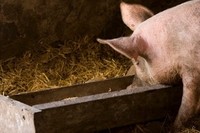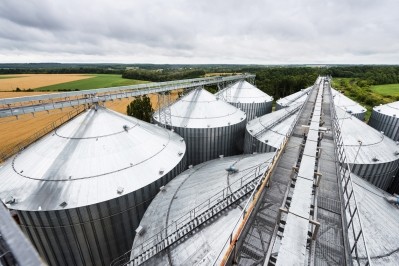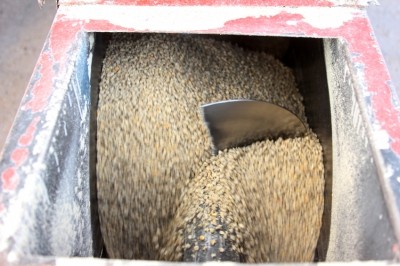Heat, sodium metabisulfite may help mitigate some contamination in pig feed

The group used pelleting because SMB needs heat and moisture to bind to DON, said team member Hyatt Frobose. And it includes both.
Additionally, researchers studied the interaction with dried distillers grain solubles (DDGS) because they tend to concentrate DON levels when compared with other corn products, they said.
The work was built off of prior research based transforming DON into a nontoxic substance, Frobose told FeedNavigator. But, they were focusing on doing so in a way that would be more accessible and usable to producers.
“We hypothesized that pelleting, particularly conditioning, could detoxify DON-contaminated feedstuffs,” the researchers said. “Using DON-contaminated DDGS, the aims of this study were to evaluate: (1) the ability of SMB to transform DON using an autoclave, (2) pelleting under varying conditions with SMB for reducing DON, and (3) the effects of pelleting either DDGS or final diets with SMB on nursery pig performance.”
Neutralizing DON
Although DON is one of the more common mycotoxins found in feed grains in North America, there isn’t an easy or completely effective way to neutralize its presence in feed, said Frobose.
Many of the additives used to address other common mycotoxins rely on a form of clay, which either binds to polar particles or encases them, he said. “That’s a great method, but DON isn’t as polar, so it isn’t as attracted, and it’s bigger, which makes it more difficult for the clays to trap it,” he added.
Other researchers have had success using mucosa from ruminants or poultry stomachs to soak DON-contaminated feed, as those species have an easier time digesting the mycotoxin, he said. That solution is able to neutralize the DON, but it isn’t practical for large-scale use.
Experiment details
The first, of four, experiments looked at using different levels of SMB in DON adulterated DDGS, said researchers. They tested adding no SMB, adding .5%, 1%, 2.5%, 5% and 5% with 100mL/kg water.
The second, pelleted the DON-contaminated DDGS along with SMB to gauge the effectiveness, they said. Four levels of DDGS were tested, with no SMB, 1% SMB, 2.5% SMB and 5% SMB.
“We tested it [the process] using a couple of bench trials, and then in a pellet mill, and got really good reduction in DON and that was exciting,” said Frobose. “So the next step was to feed it to pigs.”
The third test included 987 pigs, they said. The pigs were fed one of seven diets containing meal or pelleted DON-contaminated DDGS and no SMB, 0.25% SMB, 0.5% SMB or a positive control diet of meal without DON.
Piglets were fed for 27 days with weights and feed disappearance recorded on days 0, 7, 14, 21 and 27 to calculate average daily gain (ADG), average daily feed intake (ADFI) and the gain to feed ratio (G:F), they said.
For the last experiment, 1180 pigs were given diets comprised of a negative control with high levels of DON (4.8 mg/kg DON), the negative control diet with crumbed DDGS and a positive control with minimal DON levels, they said. The diets were used in both meal and pelleted forms.
An additional diet added 2.5% SMB to contaminated DDGS before pelleting, and then was crumbled before being fed, they said. The diets were fed for 21 days and ADG, ADFI and G:F were calculated using pig weights and feed disappearance as measured on days 7, 14 and 21.
Results
In the first experiment, adding the heat mitigated about 18.9% of the DON, but adding 5% of SMB and the heat reduced about 82% of the contamination, said the scientists. The water and SMB reduced DON levels by 94.2%.
The second found that with the inclusion of SMB, DON levels dropped quadratically.
In the third, pigs getting the contaminated feed had reduced ADG and ADFI, though pelleting appeared to boost ADG and the G:F, they said.
Adding SMB to the diet produced a linear benefit in ADG and increased ADFI, they said. Pigs getting the contaminated feed weighed less, those getting either the pelleted diets or the SMB weighed more at the end of the experiment.
In the final experiment, there was a 2-way interaction observed between the negative control diets and pelleting, they said. That process boosted the G:F in the contaminated diets to a higher level than for the diets where the contaminated DDGS were pelleted, ground and re-pelleted before being fed.
“Pigs fed diets containing high DON (3.4 mg/kg average) had decreased ADG and ADFI and pig BW throughout the test period, no differences occurred in feed efficiency,” they said. “Conversely, pigs fed pelleted diets had increased ADG, BW, and improved G:F.”
Including SMB boosted ADG and ADFI and improved body weights at days 14 and 21, they added.
“Overall, when feeding high-DON diets, using pelleting to improve feed efficiency can help offset DON-related losses in growth performance; furthermore, including low levels of SMB and pelleting may serve as a management practice to utilize DON-contaminated feedstuffs without sacrificing growth performance,” they concluded.
What’s next?
The method however, may require further experimentation as there are still details about both the pelleting process and how long a diet containing SMB can be fed, said Frobose.
When making the feed for the experiments, researchers wore protective gear because the process can release sulfur dioxide, which is an irritant, he said.
There is a concern with the diet that long-term use of SMB in the diet could cause a thiamine deficiency, he said. The use might need to be targeted toward when pigs are most susceptible to the negative growth and production effects of eating DON contaminated feed.
The researchers never saw evidence of a thiamine deficiency in their trials, but it remains a factor to consider, he said.
“The issues are not insurmountable,” he said. “What we’ve seen are some positive patterns that could answer a question that would help the producers have better performance and help pigs have a better life.”
Source: Animal Feed Science and Technology
Title: The influence of pelleting and supplementing sodium metabisulfite (Na2S2O5) on nursery pigs fed diets contaminated with deoxynivalenol
DIO: 10.1016/j.anifeedsci.2015.09.020
Authors: H.L. Frobose, E.D. Fruge, M.D. Tokach, E.L. Hansen, J.M. DeRouchey, S.S. Dritz, R.D. Goodband, J.L. Nelssen










